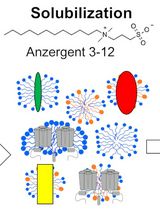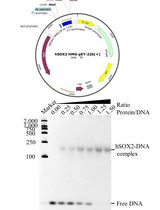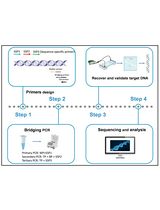- EN - English
- CN - 中文
Implementing Novel Designs in pET Expression Plasmids that Increase Protein Production
在pET表达质粒中实现增加蛋白质产量的新设计
发布: 2021年08月20日第11卷第16期 DOI: 10.21769/BioProtoc.4133 浏览次数: 7938
评审: Thibaud T. RenaultDarrell CockburnAnonymous reviewer(s)
Abstract
pET expression plasmids are widely used in the biotechnology, biopharmaceutical, and basic research sectors for the production of recombinant proteins. Typically, they are used off-the-shelf because they support high production titers; however, we have identified two design flaws in many pET plasmids that limit their production capacity. We used modern methods of DNA assembly and directed evolution to identify improved designs for these modules and demonstrated that these designs support higher protein production yields. Herein, we present two PCR protocols for implementing the designs and increasing protein production from existing pET expression plasmids.
Graphic abstract:

A simple workflow for implementing novel designs in pET expression plasmids.
Background
The basic architecture of pET expression plasmids was established over three decades ago by integrating the ϕ10 promoter for the T7 RNA polymerase (T7p) and the Tϕ transcription terminator (T7t) into the pBR322 backbone (Rosenberg et al., 1987). This architecture enables efficient transcription of cloned coding sequences in bacterial strains harbouring an inducible copy of the DE3 phage fragment encoding the T7 RNA polymerase. The basic pET vector architecture was then elaborated on by including optional add-ons. For example, a Shine-Dalgarno (SD) sequence originating from the major capsid protein of T7 (gene 10 protein) was incorporated to enable efficient translation initiation (Rosenberg et al., 1987), and the lac O1 operator sequence was cloned adjacent to the T7 promoter (T7lac) so that basal gene expression was repressed in the absence of an inducer (Dubendorf and Studier, 1991). Alternative antibiotic cassettes and purification, solubility, and secretion tags were also included. Currently, 103 different pET expression plasmids are available (Shilling et al. 2020). It is also possible to construct bespoke T7p-based expression plasmids using the modular platform for Standard European Vector Architecture (SEVA) (Silva-Rocha et al., 2013).
pET expression plasmids are currently used ‘off-the-shelf’ because they are known to support high titers of recombinant protein production - as much as 50% of the total cell protein after a few hours of induction (Mierendorf et al., 1998). Titers can also be increased by screening induction conditions or testing bacterial hosts that are supplemented with tRNAs and folding catalysts or that modulate the expression of T7 RNA polymerase (Rosano and Ceccarelli, 2014; Rosano et al., 2019). However, not all recombinant proteins can be expressed at high titers and many fall out of experimental pipelines. For example, analysis of structural genomics pipelines indicated that more than 40% of soluble proteins cannot be produced in sufficient titers for downstream structural, biochemical, and biophysical studies (Walsh, 2015; Parret et al., 2016).
In a recent study, we identified a design flaw in the T7lac module (Shilling et al., 2020). This module was originally engineered by fusing T7p to the lac O1 operator sequence in the early generation pET plasmids (Dubendorf and Studier, 1991). T7p is typically 23 nucleotides long and sits −17 to +6 relative to the messenger RNA (mRNA) start site (Figure 1) (Dunn et al., 1983). However, it was truncated by four nucleotides when lac O1 was fused, as the architects used an StuI restriction site within T7p. In our previous study, we used an overlap PCR approach to insert the four truncated nucleotides into T7lac in the most commonly used pET expression plasmid, pET28a(+). We subsequently demonstrated that this design (T7pCONSlac) increased the production titers of recombinant proteins (Shilling et al., 2020). Herein, we present a protocol for incorporating the T7pCONSlac design in vectors with an existing T7lac module (Protocol 1). This protocol is directly applicable to 88 different pET plasmids (Table 1), as well as the +LacIq-PT7/LacO (SEVA#4E) module of the pSEVA platform (Silva-Rocha et al., 2013). The remaining 15 pET vectors encode T7pCONS and do not include the lac O1 operator sequence.

Figure 1. Comparison of T7 promoters. The T7 promoter in pET28a(+) and 87 other pET plasmids is a truncated variant fused to the lac operator. Protocol 1 uses an overlap PCR approach to insert four nucleotides into the T7 promoter, thus restoring the consensus sequence and increasing production titers. Figure adapted from Shilling et al. (2020).
Our recent study also identified a design flaw in the translation initiation region (TIR) of pET28a(+). This module is a stretch of 30 nucleotides that is recognised by the 30S subunit of the ribosome during translation initiation (i.e., the first ribosomal footprint). The sequence determines the efficiency of translation initiation, the rate-limiting step in protein synthesis (McCarthy and Gualerzi, 1990; Laursen et al., 2005; Milón and Rodnina, 2012), and significantly affects the production titers of recombinant proteins (Mirzadeh et al., 2015, 2016 and 2020; Shilling et al., 2020). The sequence is usually comprised of: (1) a Shine-Dalgarno sequence complementary to the 16S rRNA subunit; (2) an AUG start codon that is situated 5-9 nucleotides downstream; and (3) the first 5 codons of the coding sequence (Shine and Dalgarno, 1975; Chen et al., 1994; Osterman et al., 2013). A large body of work indicates that the TIR works most effectively when it is largely free of mRNA structures, which promotes accessibility of the 30S subunit (Kudla et al., 2009; Plotkin and Kudla, 2011; Bentele et al., 2013; Goodman et al., 2013). In most pET expression plasmids, this region is comprised of the SD sequence and a seven-nucleotide spacer region from the major capsid protein of T7, and the first five codons of the coding sequence. However, there is no indication that this region has been optimised in any pET expression plasmid, which we considered a design flaw. We therefore carried out a directed evolution approach on the TIR in pET28a(+), which encodes an N-terminal poly-histidine tag and a thrombin protease cleavage site (Figure 2). We identified two TIRs that work more efficiently than the existing TIR, as judged by the fact that they increase protein production titers (Shilling et al., 2020). Herein, we present a protocol for incorporating the improved TIRs (Protocol 2), which is directly applicable to four of the most widely used pET plasmids (Table 1). Utilising the optimisation strategy, we noted improvements to sfGFP expression levels, starting from a low of 0.8 mg/ml to a high of 97 mg/ml, without affecting protein quality (Shilling et al., 2020). In instances where protein expression was already determined to be high, the addition of optimised TIRs described in this protocol did not always result in an increase in protein yield (unpublished data).

Figure 2. Features of the pET28a(+) plasmid and position of oligonucleotides used in the two PCR protocols. The pET28a plasmid includes the ϕ10 (T7) promoter and the lac operator, as well as the translation initiation region (TIR) encompassing the Shine-Dalgarno (SD) sequence, a spacer, and the first five codons of the open reading frame. Protocol 1 oligonucleotides (blue) incorporate four nucleotides within the T7 promoter at +3-6 relative to the mRNA transcriptional start site. Protocol 2 oligonucleotides (purple) incorporate nucleotide mutations in the TIR, which increases protein production titers.
Materials and Reagents
Petri dishes (VWR, catalog number: 391-0440)
Plate culture spreaders (VWR, catalog number: 612-1561)
Inoculation loops (VWR, catalog number: 612-9352)
50-ml conical tubes (VWR, catalog number: 525-0402)
Chemically competent E. coli MC1061
Q5 polymerase (NEB, catalog number: M0491L, storage: -20°C)
DpnI (NEB, catalog number: R0176L, storage: -20°C)
dNTPs (Thermo Scientific, catalog number: R0181, storage: -20°C)
Oligonucleotides (Eurofins Genomics)
Agarose (Sigma-Aldrich, catalog number: A9539)
O’GeneRuler DNA Ladder (Thermo Scientific, catalog number: SM1163)
DNA miniprep kit (OmegaTek, catalog number: D6943-02)
Yeast extract (Oxoid, catalog number: LP0021)
Tryptone (Oxoid, catalog number: LP0042)
NaCl (VWR, catalog number: ICNA0219473805)
Agar (VWR, catalog number: 20767.298)
Kanamycin sulfate (VWR, catalog number: 0408-EU-25G, storage: 4°C)
Ampicillin sodium salt (Sigma, catalog number: A0166-25G, storage: 4°C)
LB medium (see Recipes)
Antibiotic stock solutions (see Recipes)
LB agar (see Recipes)
50× TAE buffer (see Recipes)
DNA loading buffer (see Recipes)
Equipment
Thermocycler (Techne, catalog number: 5PRIME/02)
DNA mini horizontal submarine unit (Hoefer, catalog number: HE33)
Electrophoresis power supply (GE Healthcare, catalog number: EPS601)
Gel Imager Azure C200 (Azure Biosystems, catalog number: AC2001)
Thermomixer Comfort (Eppendorf, catalog number: 5355000.011)
New Brunswick Incubator (New Brunswick, catalog number: M1282-0012)
Benchtop centrifuge (Eppendorf, model: 5417C)
NanoDrop Spectrophotometer (Thermo Scientific, catalog number: ND-2000)
Procedure
文章信息
版权信息
© 2021 The Authors; exclusive licensee Bio-protocol LLC.
如何引用
Shilling, P. J. and Daley, D. O. (2021). Implementing Novel Designs in pET Expression Plasmids that Increase Protein Production. Bio-protocol 11(16): e4133. DOI: 10.21769/BioProtoc.4133.
分类
生物化学 > 蛋白质 > 表达
分子生物学 > DNA > DNA 克隆
您对这篇实验方法有问题吗?
在此处发布您的问题,我们将邀请本文作者来回答。同时,我们会将您的问题发布到Bio-protocol Exchange,以便寻求社区成员的帮助。
Share
Bluesky
X
Copy link













